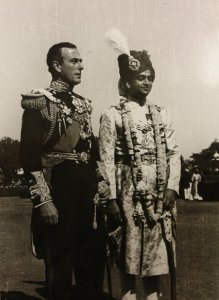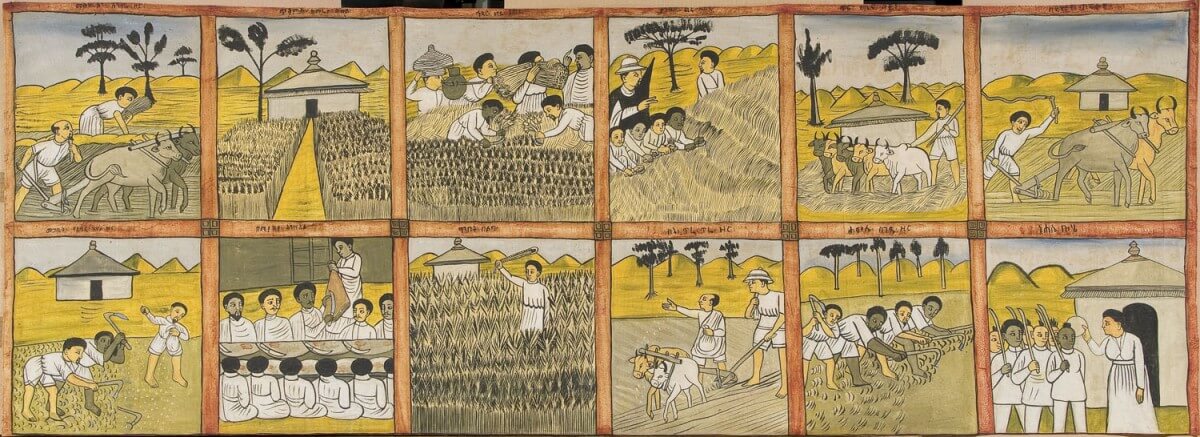Richard Pankhurst, historian and Graham C. Dorsett, photographer
This week I’ve been working through more of the collections records. I’ve completed a first sort of all the physical material in the archives and have organised chronologically the material associated with the Society loaning items to other institutions for exhibitions, drawing together the papers already in the archive and those historical ones in the office and on our computers. I am now ready to begin to catalogue these. However, before I do, I may make a little diversion, for when sorting I came across a small selection of papers belonging to Richard Pankhurst (1927-2017), the historian and founding member of the Institute of Ethiopic Studies. Pankhurst’s mother was the suffragette and anti-fascist Sylvia Pankhurst and his grandparents were Emmeline and Richard Pankhurst, so he came from a line of activists. It was through his mother’s protests concerning the Italian invasion of Ethiopia that he first became interested in the country. Growing up he met many Ethiopian refugees in London. Pankhurst studied economic history at the London School of Economics and in 1956 he went to Ethiopia to teach at the University College of Addis Ababa, subsequently becoming the founder and director of the Institute of Ethiopic Studies.
And there he might have remained all his life – embedded within the Ethiopian community. However, in 1976, after the death of Haile Selassie and the start of the Ethiopian Civil War, Pankhurst felt it necessary to leave the country. He returned to England, teaching at SOAS and LSE but, in 1978, he became the Librarian at the Royal Asiatic Society, a position he kept for several years before returning to Ethiopia in 1986. The papers I discovered belong to this time period of his life. Some of them are directly to do with his position as Librarian and therefore need to be retained within the institutional collection records. Others are to do with his own research and it is these that will become the ‘Papers of Richard Pankhurst’. During his time at the Society he continued his research into Ethiopia and even donated some Ethiopic material to the collections, the picture at the head of this blog post being one of them, representing the Ethiopian agricultural year.
Amongst the papers are some photographs. At the moment I am uncertain as to whether they are related to Pankhurst’s own interests or if they were collated in research undertaken for the Society, as these are not Ethiopian but related to India and, in particular, to the silver anniversary of His Highness the Maharaja of Jaipur Man Singh II, in 1947, and other official occasions at which Lord and Lady Mountbatten were present.

With these photographs is a profile of the photographer Graham Dorsett who received a warrant of appointment as Official Photographer to Lord Mountbatten in his role as British Viceroy and Governor General in India. Dorsett was Australian but first moved to India in 1928, joining the Bombay Light Horse. Dorsett moved into business working for a New Zealand firm before beginning his own business. In World War II he served as India’s first official war photographer, first in India and then in the Middle East and with the Indian divisions that were involved in the fall of Charen, Asmara and Massawa as well as the surrender of the Italian army in Ethiopia (this snippet of information makes me think these images should be catalogued with Pankhurst’s personal papers). He then transferred to active service in the Western Desert, Cyprus, Iraq and Syria before returning to India and taking up a civil administration post as Home Secretary and then Post War Planning Secretary in the Delhi Province. During this time he also curated an exhibition of his photographs to raise money for Indian troops welfare. The Chief Commissioner, Sir William Christie, who opened the exhibition encouraged Dorsett to become a photographer journalist once his period of government service was completed and this he did by establishing Studio Graham in Bombay (Mumbai). He covered both commercial and industrial settings alongside portraiture and cultural events, including making documentary films. He was also a photographer at three successive Olympic games – those in London (1948), Helsinki (1952) and Melbourne (1956). He retired back to Australia.

The profile with the photographs was issued by Pacific News, Honolulu, and contains few dates. It was created around the time of Dorsett’s return to Australia. Searching the Internet also provides few biographical details though a collection of his photographs probably including the ones in the Pankhurst collection can be found at the Hoover Institute Library and Archives. The photographs in our collection are copies of the originals but still provide a snapshot (pardon the pun) into life in India in the 1940s. At the moment I don’t know if Pankhurst obtained them from Pacific News or from another source.

There are only 4 photographs of a large size but also four sets of copies of the contact sheets showing the range of Dorsett’s photography at different occasions.

The contact sheets and three of the larger photographs are labelled, the two above and a further one showing Mountbatten’s daughter, Pamela. The fourth is not labelled and doesn’t appear on the contact sheets either. It shows two people in army uniform chatting on a wall, so may in fact relate to Dorsett’s time in the army. If anyone can shed light on this image, I would be grateful…

Meanwhile, I’m looking forward to sorting through the other papers relating to Pankhurst to see if I can discover more about these photos and their context within his research.

